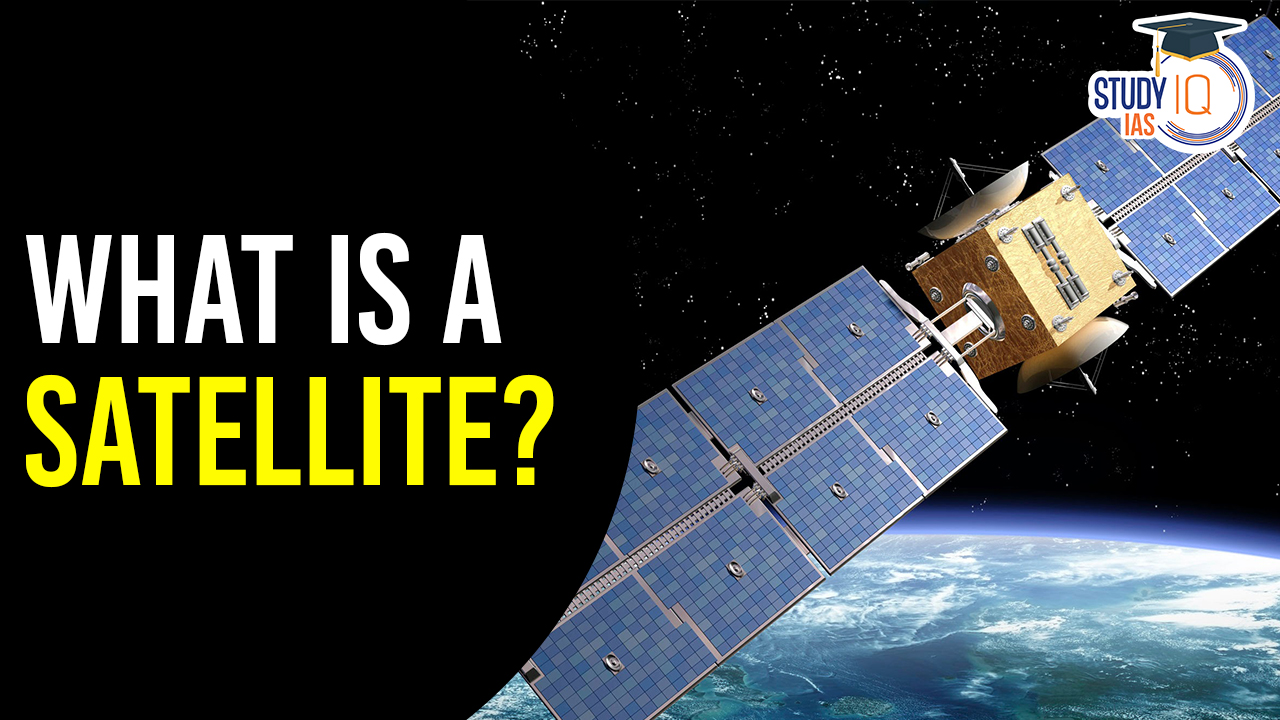Table of Contents
A satellite is an object in space that orbits or circles around a larger celestial body. There are two main types of satellites: natural and artificial. Natural satellites are celestial objects that orbit planets, with the moon orbiting Earth being a well-known example. Artificial satellites, on the other hand, are human-made objects placed into orbit around a planet. These artificial satellites serve various purposes, such as communication, scientific research, weather monitoring, and more.
What is a Satellite?
A satellite is an object in space that orbits or revolves around a larger celestial body. Satellites can be categorized into two main types: natural satellites and artificial satellites.
- Natural Satellites: These are celestial objects that naturally orbit planets. The most well-known natural satellite is Earth’s moon. Many other planets in our solar system, such as Mars and Jupiter, also have their own natural moons or satellites.
- Artificial Satellites: Artificial satellites are human-made objects placed into orbit around a planet or celestial body. They serve a wide range of purposes, including communication, scientific research, Earth observation, navigation, and more. The International Space Station (ISS) is an example of a human-made satellite that orbits Earth.
Artificial satellites can vary in size and complexity, from small CubeSats used for research to large communication satellites that provide global connectivity. They play a crucial role in modern society and have significantly advanced our understanding of space and our ability to communicate and gather information from space.
History of Artificial Satellites
The history of artificial satellites is a fascinating journey that spans several decades and is marked by significant milestones and achievements. Here is a summary of the key events and developments in the history of artificial satellites:
Sputnik 1 (1957)
The space age began on October 4, 1957, when the Soviet Union launched Sputnik 1. It was the first artificial satellite to orbit Earth.
Sputnik 1 was a spherical object with four long antennas and emitted radio signals that were detectable from Earth. Its launch initiated the space race between the United States and the Soviet Union.
Sputnik 2 (1957)
Just a month after Sputnik 1, the Soviet Union launched Sputnik 2 on November 3, 1957. This satellite carried a live passenger—a dog named Laika.
Sputnik 2 marked the first living being to orbit Earth but, tragically, Laika did not survive the mission.
Explorer 1 (1958)
On January 31, 1958, the United States launched its first artificial satellite, Explorer 1. It was a response to the Soviet Union’s Sputnik program.
Explorer 1 was equipped with scientific instruments, making it the first satellite to carry out scientific research in space. It discovered the Van Allen radiation belts around Earth.
Space Race (Late 1950s and 1960s)
The launch of Sputnik and subsequent satellites fueled the space race between the United States and the Soviet Union.
Both nations launched a series of satellites, including Luna and Vostok by the Soviets and Mercury and Gemini by the United States, with the ultimate goal of sending humans into space.
Geostationary Communication Satellites
In the 1960s, the concept of geostationary communication satellites was proposed. These satellites orbit Earth at the same speed as the planet’s rotation, allowing them to remain fixed relative to a specific location on Earth’s surface.
The launch of Syncom 3 in 1964 marked the beginning of practical geostationary communication satellites.
Space Stations
While not traditional satellites, space stations like Salyut 1 (1971) and Skylab (1973) represented the construction of habitable artificial structures in Earth’s orbit.
Space stations paved the way for long-duration human presence in space and laid the foundation for future international cooperation in space exploration.
GPS and Earth Observation Satellites
The United States developed the Global Positioning System (GPS) in the 1980s, a network of satellites that provides accurate positioning and navigation information.
Earth observation satellites, such as the Landsat series, enabled detailed monitoring of our planet’s surface for applications like environmental monitoring and urban planning.
International Space Station (ISS)
The ISS, the largest human-made structure in space, became a symbol of international cooperation in space exploration.
It was constructed in stages, with modules and components contributed by multiple countries, and it continues to serve as a platform for scientific research and international partnerships.
CubeSats and Miniaturization
The 21st century witnessed the rise of CubeSats, small and affordable satellite platforms used for various purposes, including scientific research, education, and technology demonstration.
Miniaturization of satellite components allowed for more frequent and cost-effective satellite missions.
Future Prospects
Advances in satellite technology continue to shape the future of space exploration, with plans for missions to Mars, lunar bases, and the development of mega-constellations of communication satellites, such as SpaceX’s Starlink.
| Year | Event |
| 1957 | Sputnik 1 – First artificial satellite (USSR) |
| 1957 | Sputnik 2 – Carried the first living being (USSR) |
| 1958 | Explorer 1 – First U.S. satellite |
| Late 1950s | The Space Race between the U.S. and USSR begins |
| 1960s | Introduction of geostationary communication satellites |
| 1964 | Launch of Syncom 3, a practical geostationary satellite |
| 1970s | Development of space stations (Salyut 1, Skylab) |
| 1980s | Global Positioning System (GPS) developed (U.S.) |
| 1980s-1990s | Earth observation satellites like Landsat series |
| 2000s | Construction and operation of the International Space Station (ISS) |
| 2000s | Rise of CubeSats and miniaturization of satellite technology |
| Ongoing | Continued advancement in satellite technology and space exploration |
Types of Satellites
Satellites come in various types, each designed for specific functions and purposes. Here are some of the main types of satellites:
| Type of Satellite | Primary Function |
| Communication Satellites | Facilitate long-distance communication, broadcasting, and internet services. |
| Earth Observation Satellites | Monitor and capture data about Earth’s surface, weather, climate, and natural disasters. |
| Navigation Satellites | Provide precise positioning and timing information for global navigation and geolocation. |
| Scientific Satellites | Conduct scientific research and exploration, studying celestial bodies and space phenomena. |
| Military Satellites | Serve defense and intelligence purposes, including communication, reconnaissance, and surveillance. |
| Weather Satellites | Monitor and predict weather patterns, track storms, and provide meteorological data. |
| Space Telescopes | Capture clearer and more detailed views of distant celestial objects for astronomical observations. |
| Space Station Satellites | Used for scientific experiments, technology demonstrations, and communication on the International Space Station (ISS). |
| Space Probes and Planetary Satellites | Explore and study other celestial bodies within our solar system. |
| Navigation Augmentation Satellites | Enhance the accuracy and availability of navigation signals from existing systems. |
| CubeSats and Small Satellites | Used for scientific research, education, and technology development in compact form. |
| Mega-Constellations | Large networks of interconnected satellites for global internet access and communication services. |
Satellite Orbits
Satellite orbits refer to the specific paths or trajectories that artificial satellites follow as they travel around celestial bodies, typically Earth. These orbits are carefully selected to serve specific purposes and missions. The choice of orbit depends on the satellite’s intended function, whether it’s for communication, Earth observation, navigation, or other applications. Here are some common satellite orbits:
Low Earth Orbit (LEO)
- Altitude: Typically between 160 kilometers (100 miles) and 2,000 kilometers (1,250 miles) above Earth’s surface.
- Characteristics: LEO is used for a variety of missions, including Earth observation, scientific research, and the International Space Station (ISS). Satellites in LEO complete orbits around Earth relatively quickly, allowing frequent passes over specific regions.
Medium Earth Orbit (MEO)
- Altitude: Located at medium altitudes, typically around 8,000 kilometers (5,000 miles) to 20,000 kilometers (12,400 miles) above Earth.
- Characteristics: MEO is commonly used for navigation and global positioning systems (GPS) satellites. These satellites orbit at altitudes that provide a balance between coverage and signal strength.
Geostationary Orbit (GEO)
- Altitude: Approximately 35,786 kilometers (22,236 miles) above Earth’s equator.
- Characteristics: GEO is ideal for communication satellites. Satellites in GEO orbit at the same rate as Earth’s rotation, allowing them to appear stationary relative to a fixed point on Earth’s surface. This provides continuous coverage for communication services.
Polar Orbit
- Altitude: Typically in LEO, but with an inclination that takes the satellite over the Earth’s poles.
- Characteristics: Polar orbits are used for Earth observation and remote sensing missions. Satellites in polar orbits pass over different regions of Earth on each orbit, providing global coverage over time.
Sun-Synchronous Orbit (SSO)
- Altitude: Generally in the lower to mid-range of LEO.
- Characteristics: SSO is used for Earth observation and environmental monitoring. Satellites in SSO maintain a consistent angle with respect to the Sun, which ensures consistent lighting conditions during each pass over the same region.
Molniya Orbit
- Altitude: Comprises highly elliptical orbits with a high point (apogee) in the Northern Hemisphere.
- Characteristics: Molniya orbits are used by some communication satellites, especially in high northern latitudes. The elongated orbit provides extended dwell time over specific regions, such as Russia.
Heliostationary Orbit
- Altitude: Near the orbit of Venus, approximately 261,000 kilometers (162,000 miles) from Earth.
- Characteristics: Heliostationary orbits are used for observing the Sun. Satellites in these orbits can continuously observe the Sun without interruption.
Highly Elliptical Orbit (HEO)
- Altitude: Characterized by a highly elliptical shape, often with a high apogee.
- Characteristics: HEOs are used for missions requiring extended coverage over specific regions of Earth, such as remote sensing or communication.
Satellite Mechanics: Staying in Orbit
Satellite mechanics are essential for keeping artificial satellites in orbit. To maintain a stable orbit, satellites must attain a specific velocity, known as orbital velocity, which balances the gravitational pull of the celestial body they orbit, such as Earth. The choice of orbit altitude and inclination affects coverage and functionality, and onboard propulsion systems allow for orbit adjustments over time. Stabilization and attitude control systems ensure proper orientation for sensors and instruments. Additionally, operators actively monitor orbits to avoid collisions with other space objects, and responsible end-of-life disposal practices help mitigate space debris. These mechanics underpin the reliability and effectiveness of satellites in space-based missions.
Challenges of Space Debris
- Collision Risk: Space debris poses a constant threat to operational satellites and spacecraft, risking catastrophic collisions.
- Satellite Safety: Spacecraft operators must continually adjust orbits to avoid collisions, consuming time and resources.
- Sustainability Concerns: The growing debris population threatens the long-term usability of key orbits around Earth.
- Kessler Syndrome: The potential for a self-sustaining cascade of debris collisions poses a dire future risk.
- Scientific Interference: Space debris hampers astronomical observations and space-based research.
- Astronaut Safety: Debris endangers astronauts on the ISS and during deep-space missions.
- Service Reliability: Debris can disrupt services like communication and weather forecasting.
- Debris Removal Challenges: Effective debris removal methods are technically complex and costly.
- International Cooperation: Addressing space debris requires global collaboration on regulations and mitigation strategies.
- Improved Tracking: Enhanced debris tracking and data sharing are essential for collision avoidance.
Future of Satellites
Satellite communications have evolved significantly since the launch of the pioneering Telstar 1 in 1962. Today, satellite communication services play a vital role across various industries, connecting people and businesses globally, including in remote areas. As technology continues to advance, the future of satellite communications holds great promise. In this article, we will delve into the key trends and technologies shaping this future.
OneWeb
One of the most remarkable developments in satellite communication is the rise of OneWeb. This global communications network is being constructed in low Earth orbit, utilizing a constellation of satellites to deliver high-speed, low-latency connectivity to users worldwide.
OneWeb holds the potential to provide fast and reliable internet access even in the most remote locations, revolutionizing the concept of global connectivity. This innovation extends its reach to sectors like maritime, offshore energy, and disaster response.
Maritime Software Solutions
Another noteworthy trend in satellite communications is the advancement of maritime software solutions. These tools are designed to streamline communication between vessels, crews, and onshore teams, offering real-time information and enhancing safety at sea. From satellite communication systems to weather routing software, maritime software solutions help shipping companies reduce costs, enhance efficiency, and boost overall performance.
A prime example is AST’s INTEGRA maritime software suite, which integrates all onboard communication systems into a single, user-friendly interface. This integration grants visibility and control over onboard connectivity services for both crew and onshore teams, facilitating efficient decision-making and safety enhancements.
Maritime software, such as INTEGRA, also facilitates effective bandwidth management and shields against cybersecurity threats. Managing data usage can help vessel operators control costs, a particularly valuable asset for many organizations.
Internet of Things (IoT)
The Internet of Things (IoT) is yet another transformative trend in satellite communications. By establishing real-time connections between devices and data, IoT has the potential to revolutionize industries like agriculture, offshore energy, logistics, and utilities. Satellites play a pivotal role in IoT, providing the essential connectivity to link devices and data over extensive distances. With the global reach of satellite communication services, IoT can connect even the most remote assets in the world’s most isolated locations.
5G and Beyond
The evolution of 5G and beyond promises to redefine satellite communications services, offering faster, more reliable connectivity than ever before. 5G networks will provide higher speeds, lower latency, and increased capacity, enabling a wide range of new applications and services. In satellite communications, 5G will enable novel applications such as virtual and augmented reality. For instance, an engineer might diagnose an issue on a ship using a virtual representation of the vessel, eliminating the need for physical travel.
Importance of Satellite
- Global Communication: Facilitate worldwide voice, data, and internet connectivity.
- Television and Radio Broadcasting: Distribute TV and radio signals globally.
- Navigation and GPS: Enable accurate positioning for transportation and location-based services.
- Earth Observation: Provide data for environmental monitoring and disaster management.
- Weather Forecasting: Contribute to accurate weather predictions and monitoring.
- Scientific Research: Aid in space and planetary exploration and scientific experiments.
- National Security: Support surveillance, reconnaissance, and secure communication.
- Disaster Management: Assist in coordinating disaster response efforts.
- Remote Area Connectivity: Bridge the digital divide by bringing connectivity to underserved regions.
- Commercial and Economic Impact: Drive industries such as telecommunications, agriculture, shipping, and finance.
- Space Exploration: Play a role in space missions and deploying and maintaining other satellites.
What is a Satellite? UPSC
A satellite is an object in space that orbits a celestial body. There are two types: natural (e.g., Earth’s moon) and artificial (man-made objects). Artificial satellites serve various functions, including communication, research, and weather monitoring. They’ve come a long way since Sputnik 1 in 1957, initiating the space race. Geostationary communication satellites in the 1960s revolutionized global communication.
The International Space Station (ISS) symbolizes international cooperation. The 21st century brought CubeSats and miniaturization, making space more accessible. The future holds developments like OneWeb’s global connectivity, maritime software solutions, IoT integration, and the transformational potential of 5G networks. Satellites are crucial for global communication, navigation, research, and more, connecting the world in countless ways.


 AI and its Regulation in India, Limitati...
AI and its Regulation in India, Limitati...
 Tuberculosis (TB), Symptoms, Causes and ...
Tuberculosis (TB), Symptoms, Causes and ...
 Silicon Photonics Enables Low-power AI A...
Silicon Photonics Enables Low-power AI A...





















